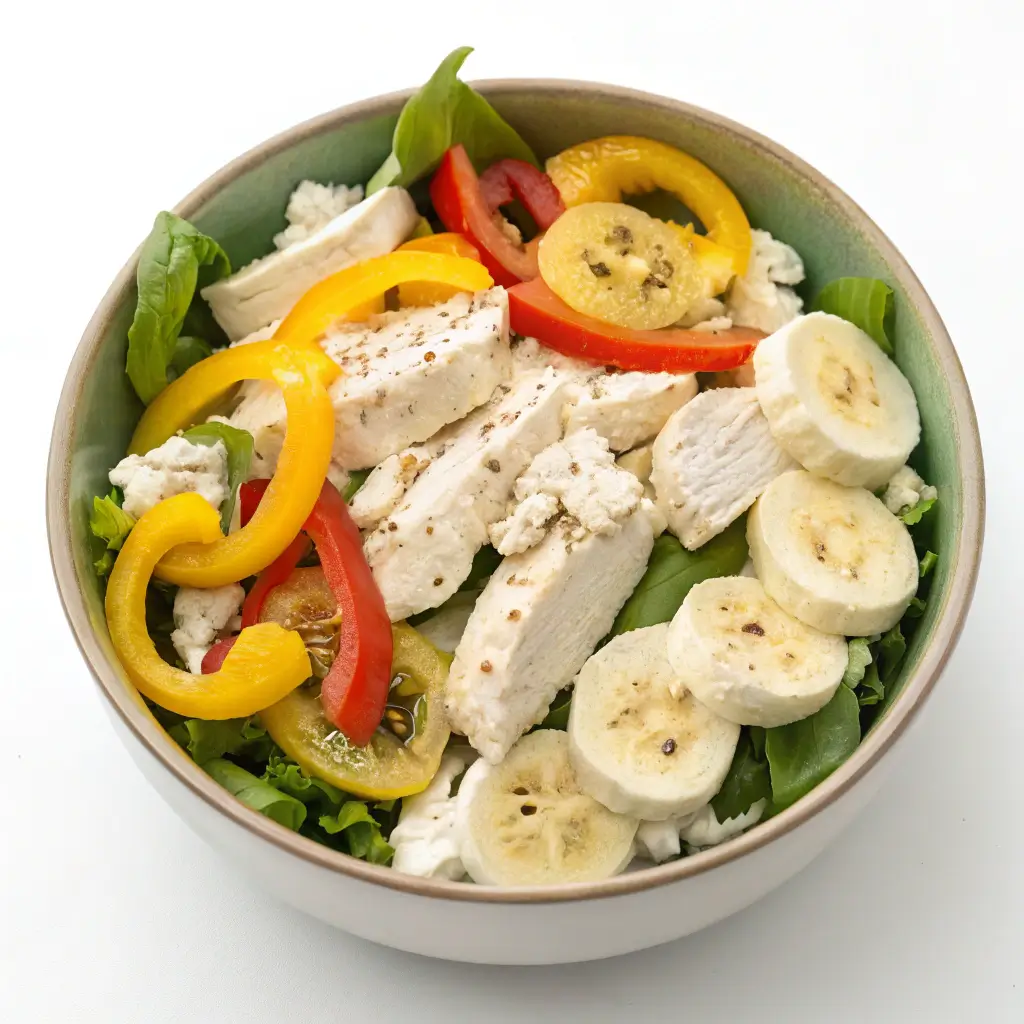Crafting a High-Protein, Low-Carb Delight: Cottage Cheese Chicken Salad with Banana Peppers
In today’s health-conscious world, balancing flavor and nutrition is no longer a luxury—it’s a necessity. Whether you’re meal-prepping for the week, hosting a summer gathering, or simply craving a light yet satisfying dish, this Cottage Cheese Chicken Salad with Banana Peppers is a game-changer. Packed with protein, low in carbs, and bursting with tangy, creamy flavors, this recipe is perfect for anyone seeking a wholesome meal without compromising on taste. Below, we’ll dive into the step-by-step guide, explore its nutritional benefits, share creative twists to make this dish your own, and even delve into the science behind its ingredients.

Why This Recipe Works: A Nutritional Powerhouse
Before we get to the recipe, let’s unpack why this salad deserves a spot in your meal rotation. First and foremost, it’s designed to fuel your body efficiently. Chicken breast, a lean protein source, supports muscle repair and keeps you full longer. In fact, a single serving of chicken breast provides nearly 30 grams of protein, making it a staple for athletes and fitness enthusiasts. Cottage cheese adds a creamy texture while doubling down on protein and providing gut-friendly probiotics. These probiotics, such as lactobacillus, promote digestive health and can even enhance immune function—a benefit often overlooked in savory dishes.
Banana peppers, meanwhile, deliver a zesty kick along with vitamin C and antioxidants—all for minimal calories. Vitamin C not only boosts immunity but also aids in collagen production, supporting skin health. Additionally, the mild heat from banana peppers can stimulate metabolism, making this salad a subtle ally for weight management.
Furthermore, this recipe skips heavy dressings and processed ingredients, making it naturally low-carb and gluten-free. Unlike traditional chicken salads that rely on sugary dressings or carb-heavy add-ins like croutons, this version emphasizes whole, nutrient-dense components. Whether you’re following a keto diet, managing weight, or simply prioritizing clean eating, this salad aligns seamlessly with your goals.
Ingredients You’ll Need: Quality Matters
To create this vibrant dish, gather the following fresh, accessible ingredients. Remember, the quality of your ingredients directly impacts the final flavor and nutritional value:
- Cooked Chicken Breast: 2 cups shredded (rotisserie chicken works well for convenience, but opt for organic or free-range varieties for cleaner protein).
- Cottage Cheese: 1 cup (choose low-fat for fewer calories or full-fat for creamier texture; look for brands with live cultures for maximum probiotic benefits).
- Banana Peppers: ½ cup sliced (mild or hot—pickled or fresh both work, but ensure they’re drained if using jarred to avoid excess sodium).
- Celery: ½ cup finely chopped (adds crunch and fiber; slice thinly for a delicate texture).
- Red Onion: ¼ cup diced (soak in cold water for 10 minutes to mellow the sharpness if preferred).
- Greek Yogurt or Mayonnaise: ¼ cup (Greek yogurt boosts protein and adds tang; mayo offers richness—use avocado oil-based mayo for healthier fats).
- Lemon Juice: 2 tablespoons (freshly squeezed for optimal brightness and vitamin C).
- Dijon Mustard: 1 teaspoon (adds depth; opt for stone-ground varieties for a rustic texture).
- Garlic Powder: ½ teaspoon (or fresh minced garlic for a bolder kick).
- Fresh Dill or Parsley: 2 tablespoons chopped (dill complements the tanginess, while parsley adds freshness).
- Salt and Pepper: To taste (use Himalayan pink salt or sea salt for added minerals).
Optional Add-Ins:
- Avocado Slices: For healthy monounsaturated fats that support heart health.
- Cherry Tomatoes: Halved for a juicy, colorful pop.
- Almonds or Sunflower Seeds: Lightly toasted for crunch and vitamin E.
- Spinach or Arugula: Fold in greens for extra fiber and iron.
Step-by-Step Instructions: Mastering the Method
Step 1: Prepare the Chicken
Start by shredding cooked chicken breast. If you don’t have pre-cooked chicken, poach two boneless, skinless breasts in simmering water for 15–20 minutes. For added flavor, poach the chicken in broth with a bay leaf and peppercorns. Let cool, then shred using forks or your hands. Alternatively, bake the chicken at 375°F (190°C) for 25–30 minutes until tender—this method enhances the chicken’s natural sweetness.
Pro Tip: Save time by using a stand mixer to shred chicken. Place warm chicken in the bowl and mix on low for 10–15 seconds—this hack delivers perfectly shredded meat in seconds!
Step 2: Mix the Base Ingredients
In a large bowl, combine shredded chicken, cottage cheese, banana peppers, celery, and red onion. Gently fold to avoid breaking down the cottage cheese too much. The goal is to maintain its creamy yet chunky texture for a satisfying mouthfeel.
Step 3: Create the Dressing
In a separate bowl, whisk together Greek yogurt (or mayo), lemon juice, Dijon mustard, garlic powder, dill, salt, and pepper. Adjust seasoning to taste—add a pinch of paprika or cayenne for extra heat if desired. For a smoother consistency, blend the dressing briefly in a food processor.
Step 4: Combine and Chill
Pour the dressing over the chicken mixture and mix until evenly coated. Seal the bowl and place it in the refrigerator for a minimum of 30 minutes to allow the flavors to blend together. This resting period allows the acidity from the lemon and banana peppers to penetrate the chicken, resulting in a more cohesive flavor profile.
Step 5: Serve and Enjoy
Scoop the salad onto a bed of leafy greens, stuff into lettuce wraps, or pair with whole-grain crackers for added crunch. Garnish with extra banana peppers, herbs, or a sprinkle of smoked paprika for visual appeal. For a portable lunch, layer the salad in a mason jar with spinach at the bottom to keep it crisp.
Nutritional Breakdown: What Makes This Salad Stand Out
One serving (approximately 1 cup) of this chicken salad provides:
- Calories: 220–250
- Protein: 28–30g
- Carbohydrates: 8–10g
- Fiber: 2–3g
- Fat: 7–9g (varies based on cottage cheese and yogurt/mayo choice)
To put this into perspective, a traditional chicken salad made with mayo and sugary additives can easily exceed 400 calories and 20g of carbs per serving. Comparatively, this version slashes carbs and calories while boosting protein—a win-win for sustained energy and satiety. Moreover, the inclusion of cottage cheese adds calcium and B vitamins, which support bone health and energy metabolism.

Creative Variations to Suit Your Palate
While the core recipe is delicious as-is, customization is key to keeping meals exciting. Here are some crowd-pleasing twists tailored to different dietary preferences and flavor cravings:
- Mediterranean-Inspired:
- Add chopped cucumbers, Kalamata olives, and a sprinkle of feta cheese.
- Swap dill for oregano and add a drizzle of olive oil.
- Serve with whole-wheat pita or cucumber slices.
- Tex-Mex Twist:
- Mix in diced avocado, cilantro, and a dash of cumin.
- Top with a squeeze of lime and crushed tortilla chips.
- To introduce a smoky note, incorporate a pinch of chipotle powder.
- Asian Fusion:
- Toss with sesame seeds, soy sauce (or tamari for gluten-free), and a drizzle of sriracha.
- Add shredded carrots or daikon radish for crunch.
- Garnish with chopped scallions and serve in butter lettuce cups.
- Vegetarian Version:
- Replace chicken with chickpeas or grilled tofu for a plant-based protein boost.
- Add roasted sweet potatoes or quinoa for a heartier texture.
- Seasonal Specials:
- Summer: Fold in fresh corn kernels and diced mango.
- Fall: Add roasted butternut squash and a sprinkle of pumpkin seeds.
- Winter: Mix in roasted Brussels sprouts and cranberries.
Meal Prep and Storage Tips: Maximizing Freshness
This salad is a meal-prepper’s dream. Here’s how to keep it fresh and flavorful throughout the week:
- Storage: Keep in a sealed container in the refrigerator for up to 4 days. To prevent sogginess, keep crunchy add-ins like nuts or seeds separate until ready to serve.
- Freezing: Freeze portions in silicone molds for up to 2 months. Thaw overnight in the fridge and stir well before eating. Note: The texture may soften slightly, but the flavor remains intact.
- Portioning: Divide into single-serving containers for grab-and-go lunches. Pair with pre-washed greens or veggie sticks for a complete meal.
FAQ: Answering Common Questions
Q: Can I use canned chicken?
A: While fresh or rotisserie chicken is ideal for flavor and texture, canned chicken (drained) works in a pinch. Rinse it well under water to lower the sodium content.
Q: Is cottage cheese necessary?
A: Yes—it provides creaminess and protein. For a dairy-free alternative, try mashed avocado or silken tofu.
Q: How can I reduce sodium?
A: Use low-sodium cottage cheese, skip added salt, and rinse banana peppers before adding.
Q: Can I make this vegan?
A: Absolutely! Substitute chicken with marinated tempeh or lentils, and use plant-based yogurt.
Q: What if I don’t like spicy food?
A: Opt for mild banana peppers or substitute with roasted red peppers for sweetness.
The Science Behind the Ingredients: Why They Work Together
Understanding the synergy between ingredients can elevate your cooking. Here’s a deeper dive:
- Chicken + Cottage Cheese: This duo creates a complete protein profile, providing all nine essential amino acids necessary for muscle repair and hormone production.
- Lemon Juice + Greek Yogurt: The acidity in lemon juice not only brightens flavors but also helps break down proteins, making the chicken more tender. Greek yogurt’s lactic acid further tenderizes the meat while adding probiotics.
- Banana Peppers + Fresh Herbs: The capsaicin in banana peppers (even mild ones) stimulates endorphin release, enhancing mood, while herbs like dill contain antioxidants that combat inflammation.
Conclusion: A Versatile Dish for Every Occasion
In summary, this Cottage Cheese Chicken Salad with Banana Peppers is more than just a recipe—it’s a versatile, nutrient-dense meal that adapts to your lifestyle. Whether you’re fueling up post-workout, packing lunches, or impressing guests at a picnic, its bold flavors and wholesome ingredients make it a standout choice. Give it a try, experiment with add-ins, and savor the satisfaction of eating well without compromise.
By prioritizing fresh ingredients, smart substitutions, and creative flair, you’ll discover just how effortless—and delicious—healthy eating can be. Share your creations online with #ProteinPackedSalad to inspire others, and don’t forget to tweak the recipe based on seasonal produce or pantry staples. Happy cooking!
